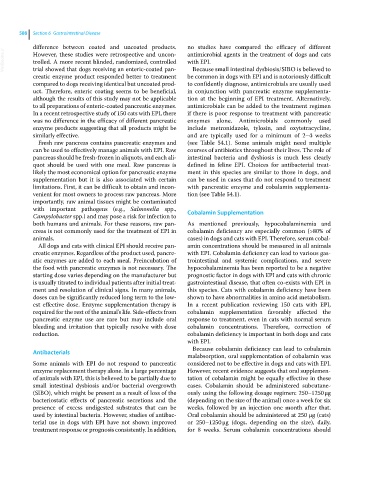Page 620 - Clinical Small Animal Internal Medicine
P. 620
588 Section 6 Gastrointestinal Disease
difference between coated and uncoated products. no studies have compared the efficacy of different
VetBooks.ir However, these studies were retrospective and uncon- antimicrobial agents in the treatment of dogs and cats
with EPI.
trolled. A more recent blinded, randomized, controlled
Because small intestinal dysbiosis/SIBO is believed to
trial showed that dogs receiving an enteric‐coated pan-
creatic enzyme product responded better to treatment be common in dogs with EPI and is notoriously difficult
compared to dogs receiving identical but uncoated prod- to confidently diagnose, antimicrobials are usually used
uct. Therefore, enteric coating seems to be beneficial, in conjunction with pancreatic enzyme supplementa-
although the results of this study may not be applicable tion at the beginning of EPI treatment. Alternatively,
to all preparations of enteric‐coated pancreatic enzymes. antimicrobials can be added to the treatment regimen
In a recent retrospective study of 150 cats with EPI, there if there is poor response to treatment with pancreatic
was no difference in the efficacy of different pancreatic enzymes alone. Antimicrobials commonly used
enzyme products suggesting that all products might be include metronidazole, tylosin, and oxytetracycline,
similarly effective. and are typically used for a minimum of 2–4 weeks
Fresh raw pancreas contains pancreatic enzymes and (see Table 54.1). Some animals might need multiple
can be used to effectively manage animals with EPI. Raw courses of antibiotics throughout their lives. The role of
pancreas should be fresh‐frozen in aliquots, and each ali- intestinal bacteria and dysbiosis is much less clearly
quot should be used with one meal. Raw pancreas is defined in feline EPI. Choices for antibacterial treat-
likely the most economical option for pancreatic enzyme ment in this species are similar to those in dogs, and
supplementation but it is also associated with certain can be used in cases that do not respond to treatment
limitations. First, it can be difficult to obtain and incon- with pancreatic enzyme and cobalamin supplementa-
venient for most owners to process raw pancreas. More tion (see Table 54.1).
importantly, raw animal tissues might be contaminated
with important pathogens (e.g., Salmonella spp., Cobalamin Supplementation
Campylobacter spp.) and may pose a risk for infection to
both humans and animals. For these reasons, raw pan- As mentioned previously, hypocobalaminemia and
creas is not commonly used for the treatment of EPI in cobalamin deficiency are especially common (>80% of
animals. cases) in dogs and cats with EPI. Therefore, serum cobal-
All dogs and cats with clinical EPI should receive pan- amin concentrations should be measured in all animals
creatic enzymes. Regardless of the product used, pancre- with EPI. Cobalamin deficiency can lead to various gas-
atic enzymes are added to each meal. Preincubation of trointestinal and systemic complications, and severe
the food with pancreatic enzymes is not necessary. The hypocobalaminemia has been reported to be a negative
starting dose varies depending on the manufacturer but prognostic factor in dogs with EPI and cats with chronic
is usually titrated to individual patients after initial treat- gastrointestinal disease, that often co-exists with EPI in
ment and resolution of clinical signs. In many animals, this species. Cats with cobalamin deficiency have been
doses can be significantly reduced long term to the low- shown to have abnormalities in amino acid metabolism.
est effective dose. Enzyme supplementation therapy is In a recent publication reviewing 150 cats with EPI,
required for the rest of the animal’s life. Side‐effects from cobalamin supplementation favorably affected the
pancreatic enzyme use are rare but may include oral response to treatment, even in cats with normal serum
bleeding and irritation that typically resolve with dose cobalamin concentrations. Therefore, correction of
reduction. cobalamin deficiency is important in both dogs and cats
with EPI.
Because cobalamin deficiency can lead to cobalamin
Antibacterials
malabsorption, oral supplementation of cobalamin was
Some animals with EPI do not respond to pancreatic considered not to be effective in dogs and cats with EPI.
enzyme replacement therapy alone. In a large percentage However, recent evidence suggests that oral supplemen-
of animals with EPI, this is believed to be partially due to tation of cobalamin might be equally effective in these
small intestinal dysbiosis and/or bacterial overgrowth cases. Cobalamin should be administered subcutane-
(SIBO), which might be present as a result of loss of the ously using the following dosage regimen: 250–1250 μg
bacteriostatic effects of pancreatic secretions and the (depending on the size of the animal) once a week for six
presence of excess undigested substrates that can be weeks, followed by an injection one month after that.
used by intestinal bacteria. However, studies of antibac- Oral cobalamin should be administered at 250 μg (cats)
terial use in dogs with EPI have not shown improved or 250–1250 μg (dogs, depending on the size), daily,
treatment response or prognosis consistently. In addition, for 8 weeks. Serum cobalamin concentrations should

